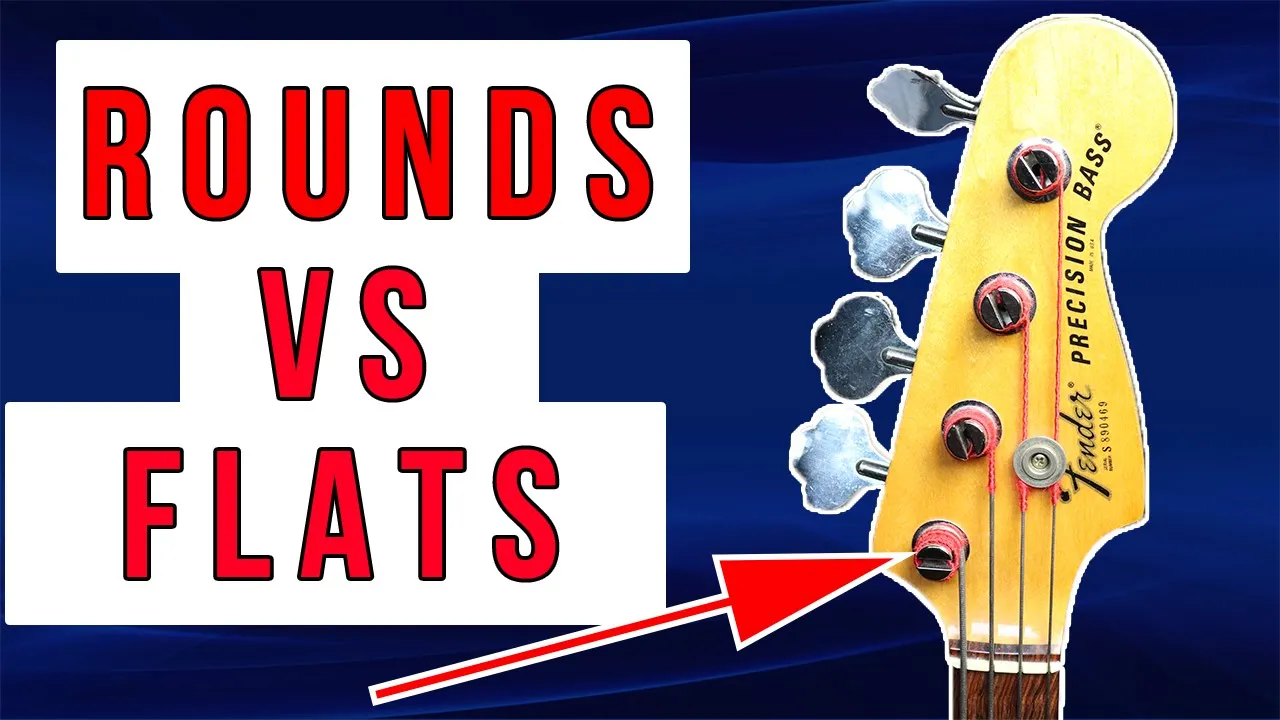Bass strings are a crucial part of any bass player’s set-up, with each type offering its own unique sound and feel. One common kind of string is the flatwound variety—they have been around for many years and offer a range of benefits. In this article, we’ll give you an overview of what flatwound bass strings are, along with some tips on which ones to buy. So if you’re looking for that special something in your tones, read on to find out more about flatwound strings!
The Best Flatwound Bass Strings: Buying Advice
Flatwound strings are becoming increasingly popular, due to the range of sounds they offer and how well they can tackle genres like funk, blues, and classic rock. You’ll find lots of different types of flatwound strings on the market, so it pays to do your research and buy from a reputable company. Here are a few factors you should consider when selecting your strings:
Tension: this affects how easily your strings bend and how tight or loose you want them to feel.
Budget: One flatwound string will cost more than another and that’s just something you have to deal with. Think about how often you play bass and how much you want the flatwound sound when yoy play bass. If they’re a vital part of your set up then it’s worth spending more.
Material: many modern flatwound strings use stainless steel for optimum durability. This has pros and cons. Steels typically have more low and high end which can make for a great bass sound. But if you want a more old-school bass sound then look at using nickel strings which offer more mid range.
Flatwound Strings: Our Top Picks
Differences In Construction
Flatwound strings differ in construction from round wound strings as they have smooth outer surfaces which create less friction against the fingerboard than round wound models. This gives them a mellower, warmer tone—perfect for producing those classic vintage sounds! It’s this warm sound that makes flat wounds particularly attractive for jazz playing styles—although they work equally well in other contexts too.
Additionally, flatwound strings tend to last longer than their round wound counterparts, making them great value for money if you play regularly. However they require more tension than round winding alternatives, meaning they may take some time to adjust to if you’re used to playing with lighter gauges.
Flatwound Strings: How Do They Feel?
For experienced players who often switch between different string gauges, the difference in tension between flat windings could seem significant at first—but it shouldn’t put you off trying them out!
In general, flat windings are known for offering a crisp attack without compromising on warmth or clarity; making them perfect for both punchy articulation as well as subtle nuances in playing style. They also add sustain without sacrificing their characteristic low tone—something that is often missing from round wound offerings.
La Bella 760FS
The La Bella 760FS set is one of the most popular brands of flat wounds currently available; adopted by artists including legendary Motown bassist James Jamerson and renowned jazz player Ray Brown right through to modern funk king Pino Palladino (noted for his work with John Mayer).
The ‘FS’ stands for ‘Flat Steel String’; referring to the fact that these are made with pure stainless steel rather than having a wrap around it like traditional ones do– giving them extra bite and clarity alongside greater resistance over time wear wise!
Half Wound, Flat Winded And Round Wound Strings
Finally we need to address the differences between halfwinded (often referred to as ‘stainless steel tape wound’) versus traditional round wound strings–which are wrapped as opposed having a smooth surface like our beloved flats!
In essence half-winded combine elements from both worlds; creating additional clarity (with minimal fuzziness) whilst not requiring as much tension as its all-flat counterparts just discussed above! As such these are perhaps ideal for those seeking something with characteristics from both ends of tonal spectrum–spanning across multiple styles/genres quite effectively!
How About Sound?
From a sound point of view, flatwound strings are known for offering an even response across the entire tone range. This makes them great for players who need to maintain clarity and punch in their playing—say for example if you find yourself playing complex passages with lots of notes! Flatwounds also boast a rich harmonic content that can provide warmth and depth which is perfect for blues, jazz, funk and classic rock styles.
D’Addario XL ECB81 Chromes Flat Wound
The D’Addario XL ECB81 Chromes Flat Wound is highly regarded by many bass players. Known for its bright tone without losing any of its resonance or bottom-end punch, this set also boasts excellent durability as they are constructed from stainless steel.
They come delivered in a comfortable gauged tension (perfect for those used to regular stringwear) and offer smooth intonation due to their well-designed winding process. This makes them an ideal option for studio work or on-stage use.
Recording Vs. Performing
When it comes to recording versus performing live–flatwounds have somewhat of an edge when it comes to recording applications. Their even tonal balance helps producers get the most out of their bass parts whilst still preserving warm tones needed in certain genres like blues and jazz which often require more subtlety when tracking parts together!
On the other hand however, flatwounds lack some of the ‘dynamic snappiness’ that round wound strings tend to bring into performance–which means a slightly less lively performance but one with greater consistency across songs/sets as it concerns pitch accuracy et al!
So Flat Wounds Don’t Have Any Disadvantages?
Whilst it’s true that flat wounds offer plenty of benefits, they do have some drawbacks too. One is that they require more tension than round wound alternatives; meaning guitarists may take longer to adjust if switching from lighter string gauges!
Additionally, the increased level of resistance due to the winding process can result in slightly weaker lows compared to round windings–especially when playing palm-muted rhythms at faster tempos. That said however these issues can be easily outweighed by attention to playing technique and proper intonation practice!
What Are Tapewound Bass Strings?
Tapewound bass strings are much like flatwounds in that they offer a smooth surface with less friction than their round wound counterparts. However, their construction is slightly different as they use a thin tape to wrap around the core of the string which helps give them extra dynamic range and clarity.
They are becoming increasingly popular for genres like funk and blues as well as jazz because of their ability to produce those classic vintage sounds!
GHS Precision Flats
The GHS Precision Flats set is another great choice when it comes to tapewound strings. With an ultra-smooth feel, these strings offer plenty of tone without sacrificing any warmth or resonance.
They are also quite resilient, making them perfect for those who play regularly and need a long-lasting set of bass strings!
Ernie Ball Flatwound Bass Group Flats
The Ernie Ball Flatwound Bass Group Flats are a go-to choice for many professional players. These strings have a bright attack while still providing warmth and clarity—making them great for all genres from jazz to rock!
Additionally, due to their stainless steel construction, they offer increased durability and reduced fingerboard wear over time; allowing bass players to focus more on playing rather than having to change out old strings every few weeks!
DR Strings Legend Flatwounds
DR Strings’ Legend Flatwounds are one of the most popular flatwounds currently available on the market today. Known for their silky feel and comfortable tension levels, these strings provide an overall warm tone–perfect for styles from metal/rock through funk and soul as well as jazz music!
The premium nickel alloy winding ensures these strings retain their sound quality over time whilst offering maximum longevity–ensuring you won’t have to worry about changing your strings too often!
Reasons to avoid
Here is a list of reasons to avoid DR Strings’ Legend Series Flatwound Bass Strings:
Lower tension levels compared to standard flatwound strings which may not suit all playing styles.
Limited availability in certain regions as they’re not widely stocked by major retailers and distributors.
Higher cost due to the higher quality materials used in the construction process.
Can take time to break-in before attaining optimum sound quality and feel from the strings.
Possible fingerboard wear over time if not maintained and stored properly.
Reasons to buy
Here is a list of reasons to buy DR Strings’ Legend Series Flatwound Bass Strings:
Ultra-smooth feel for maximum comfort.
Maximum clarity and warmth for any genre from jazz to rock.
Premium nickel alloy winding ensures long lasting sound quality and reduced fingerboard wear over time.
Silky playability with comfortable tension levels for extended playing sessions.
Corrosion resistant coating for increased durability and longevity.
Rotosound Jazz Bass 77 Flats
Rotosound’s Jazz Bass 77 flats are a classic choice for many veteran players. With a bright tone and treble response, these strings offer a great balance of attack and sustain–suitable for playing jazz, funk and other styles where clarity is key! These strings also boast excellent intonation due to the winding process; meaning you don’t have to worry about tuning issues during performances or studio sessions!
Thomastik-Infeld JF344 Jazz Flats
Thomastik’s JF344 Jazz Flats provide players with an outstanding combination of tone and playability. Constructed from nickel-plated steel, these strings provide plenty of warmth as well as increased resonance throughout the entire sonic range–making them perfect for country blues and traditional jazz. Additionally, they come in four gauges from extra-light to medium–which makes it easy to find the perfect tension for your particular playing style!
La Bella LTF-4A Low Tension Flexible Flats
The La Bella LTF-4A Low Tension Flexible flats are another popular choice amongst bassists. Offering a balanced tone with increased flexibility due to their low-tension design, these strings are great for anything from jazz to reggae or funk music. Plus they also include anti-rust coating which gives them extra durability while still providing that traditional warm sound associated with flatwounds!
Pyramid Gold Pure Nickel Flatwound
Pyramid’s Gold Pure Nickel Flatwound set offers players one of the best all round flatwinds available on the market today. Their pure nickel construction ensures plenty of warmth whilst still retaining plenty of attack too–making them suitable for most genres ranging from rock/metal through soul/funk right up to jazz! These strings also provide excellent durability thanks to their corrosion resistant coating; ensuring maximum comfort when playing live or studio situations!
What are flatwound strings good for?
Flatwound bass guitar strings are best for styles of music that require a warmer sound and a more mellow tone such as soul, motown and R&B. That being said, players like Steve Harris of Iron Maiden have used them very successfully to play heavier rock and metal.
Which bass players use flatwound strings?
Famous players who use this string type include James Jamerson, Pino Palladino and Steve Harris to name a handful. There will of course be others.
Are flatwound strings easier?
It really depends on the player. When compared to a roundwound string, some electric bass players do find them a little harder and stiffer but that may be because they aren’t used to them. Many upright bass players feel at home with both flatwound and roundwound strings because flats are closer to what a double bass uses and roundwound bass strings are often naturally less stiff.









Leave a Reply